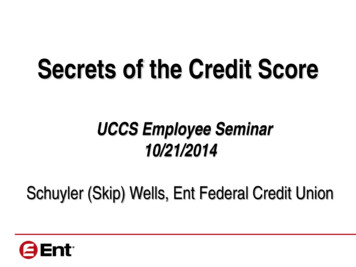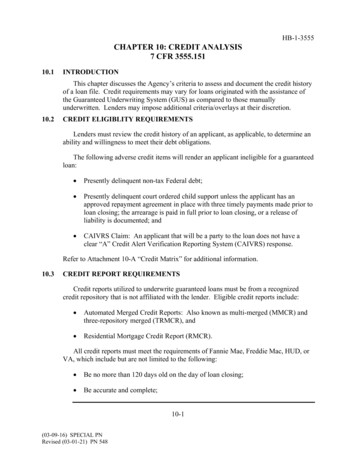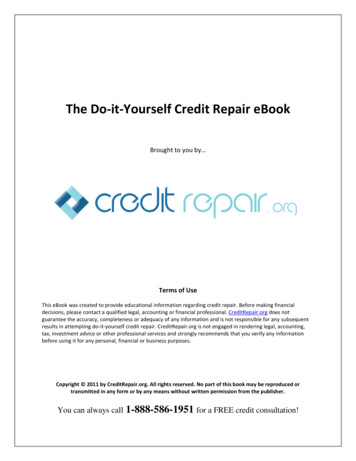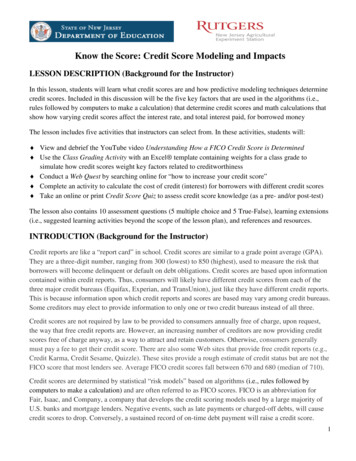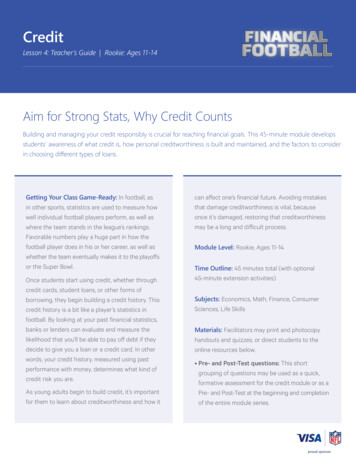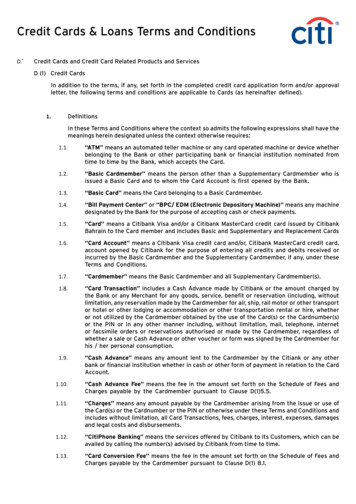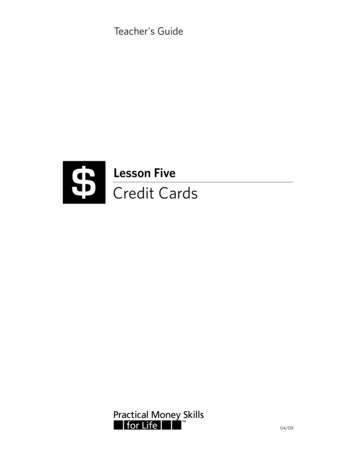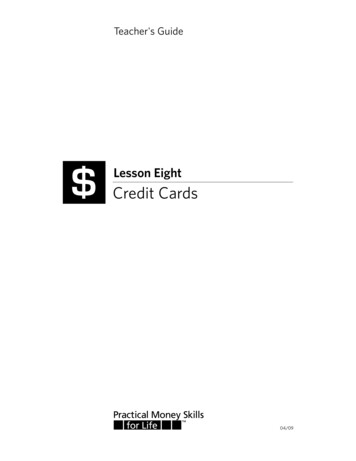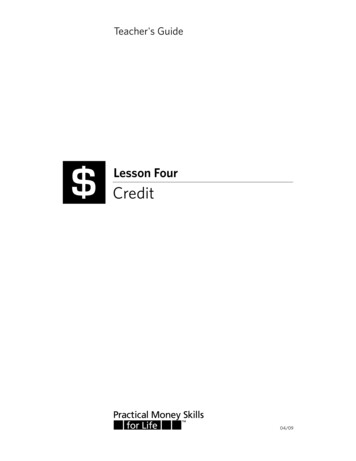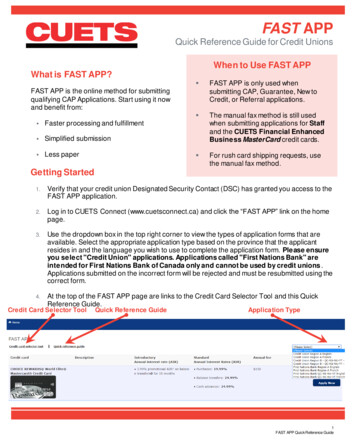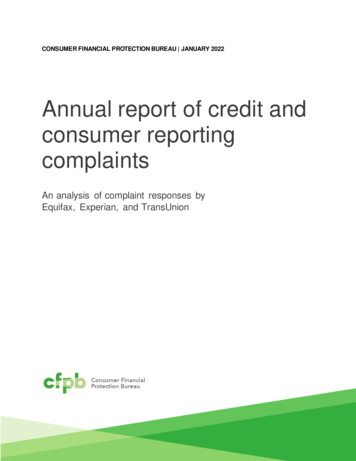
Transcription
CONSUMER FINANCIAL PROTECTION BUREAU JANUARY 2022Annual report of credit andconsumer reportingcomplaintsAn analysis of complaint responses byEquifax, Experian, and TransUnion
Table of ContentsTable of Contents .2Executive Summary .31.Introduction .52.Background .103.4.2.1Credit reporting overview. 102.2Dispute process .122.3CFPB complaint process. 142.4Credit monitoring, credit repair, and credit education . 16Complaint data .213.1Factors underlying complaint volume increases . 243.2Consumer issues and harms. 29Fair Credit Reporting Act Section 611(e) .394.1The Fair and Accurate Credit Transactions Act . 394.2 Transmission of complaints and data collection .405.6.NCRA complaint response analysis .445.1Previous dispute attempts . 455.2NCRAs’ changes to complaint responses .46Conclusion.55
Executive Summary Pursuant to Section 611(e)(5) of the Fair Credit Reporting Act (FCRA), this reportsummarizes information gathered by the Consumer Financial Protection Bureau (CFPB)regarding certain consumer complaints transmitted by the CFPB to the three largestnationwide consumer reporting agencies (NCRAs)—Equifax, Experian, and TransUnion. The CFPB historically has satisfied its annual reporting obligation by including informationgathered pursuant to FCRA Section 611(e) in its Consumer Response Annual Report. Thisyear, however, increased complaint volume about the NCRAs and the NCRAs’ concurrentchanges in response to those complaints led the CFPB to publish this independent report. From January 2020 to September 2021, the CFPB received more than 800,000 credit orconsumer reporting complaints. Of these complaints, more than 700,000 were submittedabout Equifax, Experian, or TransUnion. Complaints submitted about the NCRAs accountedfor more than 50% of all complaints received by the CFPB in 2020 and more than 60% in2021. The CFPB’s analysis shows that consumers are submitting more complaints in eachcomplaint session and are increasingly returning to the CFPB’s complaint process. In their complaints to the CFPB, consumers describe harms stemming from their failedattempts to correct incomplete and inaccurate information on their credit reports:3 Consumers are caught in an automated system where they are unable tohave their problem addressed. Consumers described how they attempted todispute inaccurate information with the NCRAs but were unsuccessful. Attempts tohave their problems addressed timely appear especially important to consumers whoare making large financial transactions, such as buying a house, or applying forhousing or employment. Consumers waste time, energy, and money to try to correct their reports.Consumers described the burden associated with attempting to correct inaccurateinformation, which can be compounded when they are managing other personalissues. Some consumers reported discovering that debts (such as medical bills) hadbeen reported to their credit report without their knowledge. Consumers describedBUREAU OF CONSUMER FINANCIAL PROTECTION
being exasperated by the dispute process and some consumers described paying billsthey did not think they owed because of concerns about the effect of the debt on theircredit report and credit score. Consumers are caught between furnishers and the NCRAs. Consumersdescribed attempting to dispute incorrect information with both data furnishers andthe NCRAs. Consumers said that when furnishers and the NCRAs point fingers atone another, they have limited avenues to resolve the problem, which can beespecially difficult for identity theft victims. Consumers have the right to dispute inaccurate and incomplete information on their creditreports. Consumers also have the right to submit complaints to the CFPB. Most complaintsabout the NCRAs received by the CFPB during 2020 and 2021 met the statutory criteria thatmandates the NCRAs review these complaints and respond to the CFPB. In 2020, Equifax, Experian, and TransUnion changed how they respond to complaintstransmitted to them by the CFPB. The CFPB’s analysis reveals that the NCRAs are closingthese complaints faster and with fewer instances of relief. In 2021, the NCRAs reported reliefin less than 2% of complaints down from nearly 25% complaints in 2019. 4 Pursuant to the Dodd-Frank Wall Street Reform and Consumer Protection Act, theCFPB’s complaint process allows for the submission of complaints by consumers’third-party representatives. The CFPB expects the NCRAs to respond to complaints,including complaints where they have an obligation to do so under FCRA Section611(e), when submitted by consumers and representatives acting on their behalf. The NCRAs ignore this obligation and, instead, do not respond when they suspectthat a third party was involved in the submission of the complaint. The NCRAs relyon speculative criteria in reaching these decisions. The NCRAs’ actions leave many consumers without a response to the issues theyraised in their complaints.The FCRA requires the NCRAs to conduct a review of certain complaints sent to them by theCFPB and to report their determinations and actions to the CFPB. The NCRAs’ responses tothese complaints raise serious questions about whether they are unable—or unwilling—tocomply with the law.BUREAU OF CONSUMER FINANCIAL PROTECTION
1. IntroductionCredit reports1 play an important role in the lives of consumers. Lenders often rely on thesereports when determining whether to approve loans and what terms to offer. Landlords mayreview reports to decide whether to rent housing to prospective tenants. Employers may checkreports as part of the job application process. Given the consequential decisions for which creditreports are considered, it is imperative that the credit reporting system maintain and distributedata that are accurate. Access to an effective and efficient dispute management and resolutionprocess is legally required and essential to maintain the accuracy of consumers’ data.Complaints submitted to the Consumer Financial Protection Bureau (CFPB) about inaccurateinformation and the dispute process make up a significant share of all complaints received bythe CFPB, and the complaint process provides a key backstop to dispute channels available toconsumers.2There are several actors who make up the credit reporting system: furnishers provideinformation about consumers to consumer reporting agencies that, in turn, compileinformation and make it available to lenders and other users. Pivotal to this system are the threelargest nationwide consumer reporting agencies (NCRAs): Equifax, Experian, and TransUnion.More than 200 million Americans have credit files and nearly 15,000 providers furnish1Credit reports, a popular term for consumer reports that typically contain information about credit accounts andother trade lines as well as information from public records, are provided by the nationwide consumer reportingagencies and other consumer reporting agencies to lenders and other users. See, e.g., Consumer Fin. Prot. Bureau,Key Dimensions and Processes in the U.S. Credit Reporting System (2012),https://files.consumerfinance.gov/f/201212 cfpb credit-reporting-white-paper.pdf. See also 15 U.S.C. § 1681a(d).2See Fed. Trade Comm’n., Report on Complaint Referral Program Pursuant to Section 611(e) of the Fair CreditReporting Act (Dec. 2008), reports/section df (“The [611(e)] programwas intended to enable consumers to obtain a second review of their complaints when they remain dissatisfied afterhaving completed the dispute process with the CRAs .”).5BUREAU OF CONSUMER FINANCIAL PROTECTION
information about consumers to the NCRAs.3 Thus, the NCRAs’ actions—and inactions—havelarge implications for consumers’ financial well-being and the economy more broadly.4The Fair Credit Reporting Act (FCRA) imposes various requirements on certain entities thatregularly compile and disseminate personal information about individual consumers. 5 TheCFPB and the Federal Trade Commission (FTC) are the federal agencies with the principalresponsibility for enforcing the FCRA.6 In addition to its enforcement authority, the CFPB hasrule writing authority under the FCRA, as well as supervisory authority over many of the keyinstitutions in the consumer reporting system. The CFPB is also tasked with compiling andtransmitting to the NCRAs certain complaints from consumers about them.7 The CFPB carriesout this responsibility through its consumer complaint process. 83See, e.g., Equifax, Equifax Investor Day (2021) at 70,https://d1io3yog0oux5.cloudfront.net/ 9204/pdf/EFX 2021 Investor Day Presentation .pdf (more than 220 million consumers); Experian, Frequently Asked Questions onCredit Reports, rt-faqs (more than 220 million consumers)(last visited Dec. 4, 2021); TransUnion, Customer Credit omer -credit-check (more than 200 million files) (last visited Dec. 4,2021); Consumer Fin. Prot. Bureau and Fed. Trade Comm’n., Accuracy in Consumer Reporting Part c accuracy in consumer reporting workshop transcript segment 1 12-10-19.pdf (“right now, we have a verydiffused furnisher population, about 14,000 to 15,000 furnishers”). See also Kenneth Brevoort, Phillip Grimm &Michelle Kambara, Consumer Fin. Prot. Bureau, Data Point: Credit Invisibles (May 2015),https://files.consumerfinance.gov/f/201505 cfpb data -point-credit-invisibles.pdf (CFPB research estimating that188.6 million Americans have credit records at one of the NCRAs that could be scored and an additional 19.4 millionAmericans have credit records that cannot be scored.).4See, e.g., House Financial Services Comm., Oversight and Investigations Subcomm., Consumer Credit Reporting:Assess Accuracy and Compliance, 117th Cong. (May 26, 2021) (“House Hearing on Consumer Credit Reporting”)(opening statement of Rep. Green, “Whether in assessing credit, employment, housing, insurance or even utilities, theinformation provided by the major NCRAs has the power to either open or foreclose a vast array of opportunities thatundergird economic security and social justice for consumers”; opening statement of Rep. Barr, “The allocation ofcredit is the lifeblood of the American economy, lenders, insurers and other financial firms rely on accurate creditreports to reflect the potential risk of a customer.”).515 U.S.C. § 1681 et seq.6See Senate Comm. on Banking, Housing, and Urban Affairs, An Overview of the Credit Bureaus and the Fair CreditReporting Act, 115th Cong. (July 12, 2018) (S. HRG. 115-361), 83/pdf/CHRG-115shrg32483.pdf (“An Overview of the Credit Bureaus”).715 U.S.C. § 1681i(e)(1).8 Seediscussion infra Section 2.3. See also Consumer Fin. Prot. Bureau, Learn how the complaint process ocess/.6BUREAU OF CONSUMER FINANCIAL PROTECTION
Reporting requirement and scopeUnder the FCRA, the CFPB must submit an annual report to Congress regarding informationgathered by the CFPB about certain complaints9 it transmits to the NCRAs.10 In prior years, theCFPB met this reporting requirement by including additional company-level, summaryinformation in the Consumer Response Annual Report. 11 In 2020, however, significant changesin complaint volume and the quality of responses provided by the three largest NCRAs led theCFPB to publish this stand-alone report.12In addition to meeting the FCRA reporting requirement, this report uses consumer complaintinformation to provide the public with important context about the consumer reportingmarketplace and to provide policymakers with timely information, context, and analysis as theydeliberate various legislative proposals that would affect the credit reporting system. 13This report proceeds in the following sections. Section 2 begins by providing an overview of thecredit reporting system, including the dispute process, the CFPB complaint process, and theparticipation of other actors. Section 3 discusses consumer complaints to the CFPB and theissues consumers experience when reviewing and attempting to correct their credit reports.Section 4 traces the evolution of the FCRA 611(e) process since it became law in 2003. Section 5provides information required by FCRA Section 611(e)(5), including observed complaintresponse patterns and other information captured by the CFPB’s consumer complaint process.Finally, Section 6 concludes this report.Data sourcesThe data used in this report comes from two primary sources. The first is CFPB complaint datacollected during the consumer complaint process. The consumer complaint process, which isdescribed more fully in Section 2.3, collects information from both consumers and companies.9See discussion of covered complaints infra Section 4.1.1015 U.S.C. § 1681i(e)(5).11See, e.g., Consumer Fin. Prot. Bureau, Consumer Response Annual Report (Mar. s/cfpb consumer-response-annual-report 2019.pdf.12See Consumer Fin. Prot. Bureau, Consumer Response Annual Report (Mar. 2021) at fpb 2020-consumer-response-annual-report 03-2021.pdf (“Duein part to the increase in complaint volume, the Bureau will issue a separate report later this year to provide a morerobust analysis of these comp laints and responses.”).13See, e.g., Protecting Consumer Access to Credit Act, H.R. 1645, 117 th Congress (2021); Comprehensive CreditReporting Enhancement, Disclosure, Innovation, and Transparency Act of 2021 , H.R. 4120, 117 th Congress (2021);Medical Debt Relief Act of 2021, S.214, 117 th Congress (2021); Consumer Credit Control Act of 2021, S.1343, 117 thCongress (2021).7BUREAU OF CONSUMER FINANCIAL PROTECTION
The CFPB makes a subset of this data publicly available in the Consumer Complaint Database.14This report primarily focuses on complaint data from January 2020 to September 2021;however, data going back to 2018 is included to provide additional context. 15 From January2020 to September 2021, the CFPB received more than 800,000 credit or consumer reportingcomplaints. Of these complaints, more than 700,000 were submitted about Equifax, Experian,or TransUnion.The second data source is information gathered from several dozen informal interviews withconsumers who submitted complaints to the CFPB. The CFPB conducted these interviews togain a more complete understanding of consumers’ experiences with the CFPB’s consumercomplaint process.16 Additionally, the CFPB spoke with non-profit credit counselors and theConsumer Data Industry Association (CDIA), an international trade association representingconsumer data companies. These conversations have informed this report.TerminologyThe FCRA sets forth definitions and rules of construction of many key terms.17 The CFPB isproviding this glossary to aid comprehension of this report only.18 For the purposes of thisreport, the CFPB uses the following terms: Consumer complaint: submissions to the CFPB that express dissatisfaction with, orcommunicate suspicion of wrongful conduct by, an identifiable entity related to aconsumer’s personal experience with a financial product or service. Section 2.3 discussesthe complaint process in more detail. Consumer reporting agency (CRA): a company that assembles or evaluates informationon consumers and sells information in the form of consumer reports.14See Consumer Fin. Prot. Bureau, Consumer Complaint Database , mer-complaints/. See also Disclosure of Consumer Complaint Narrative Data, 80 FR 15572 (Mar. 24,2015), ative-data.15This report fulfills the CFPB’s reporting requirement for complaints receiv ed from January to December 2020.Complaints received before and after this reporting period are included for context.16These interviews are a valuable way to better understand the lived experiences of consumers who used the CFPBcomplaint process; however, they are not intended to give the CFPB statistically significant data that can begeneralized to all consumers.17See 15 U.S.C. § 1681a.18 The terms defined in this glossary are intended to enhance the readability for the audience, rather than to reflect alegal interpretation by the CFPB.8BUREAU OF CONSUMER FINANCIAL PROTECTION
199 Nationwide consumer reporting agency (NCRA): a consumer reporting agency thatcompiles and maintains files on consumers on a nationwide basis regarding aconsumer’s credit worthiness, credit standing, or credit capacity. In this report, the CFPBuses the term NCRAs to refer to Equifax, Experian, or TransUnion. Covered complaints: complaints submitted to the CFPB about the NCRAs concerningincomplete or inaccurate information where the consumer also appears to have disputedthe completeness or accuracy with the NCRA. The FCRA requires the NCRAs to subjectthese complaints to additional review when the CFPB transmits the complaints to theNCRAs.19 Section 5 analyzes these complaints. Credit report: a consumer report provided by a NCRA to a user (such as a lender or debtcollector) that typically contains information such as the payment history and status ofcredit and other accounts. Credit file or consumer file: the information about a consumer that is contained in aCRA’s database. The term file, when used in connection with information on anyconsumer, means all the information on that consumer recorded and retained by a CRAregardless of how that information is stored. Dispute: the FCRA requires CRAs and furnishers to reinvestigate information containedin a consumer’s credit file when the consumer disputes the accuracy or completeness ofthat information. Consumers can dispute an item of information through a CRA (indirectdisputes), through the furnisher who provided the disputed information (directdisputes), or both. Section 2.2 summarizes the dispute process. Furnisher: an entity that furnishes information relating to consumers to one or moreCRAs for inclusion in a consumer report. Trade line: information furnished by a creditor to a CRA that reflects the consumer’saccount status and activity, such as balance owed and payment history.This additional review is detailed at FCRA Section 611(e)(3), 15 U.S.C. § 1681i(e)(3).BUREAU OF CONSUMER FINANCIAL PROTECTION
2. BackgroundThis section provides background on the credit reporting system, focusing on the parts of thesystem that interact with the CFPB’s complaint process. It discusses, in turn, the dispute process(Section 2.2), the complaint process and its relationship to the dispute process (Section 2.3), andactors that may play a role in consumers’ efforts to monitor their credit reports and attempt toimprove their credit standing (Section 2.4). Specifically, Section 2.4 addresses credit repairorganizations and emerging forms of credit education.2.1Credit reporting overviewThe basic structure and operation of the credit reporting system is largely unchanged over thelast several decades. 20 CRAs assemble or evaluate consumer information from lenders and otherdata furnishers and from public record providers to produce consumer reports and credit scoresthat users rely on to make decisions.The data standards that govern these data exchanges have evolved. The Metro 2 Format21, asystem of shorthand codes and fields to report trade lines, has now fully supplanted the Metro 1Format.22 But credit reports are still made up of some or all of the following components:20See Consumer Fin. Prot. Bureau, supra note 1.21The credit industry’s trade association, the Consumer Data Industry Association, created the Metro 2 Format. It is astandardized electronic data reporting format used by data furnishers to furnish consumer credit account data. Seegenerally Consumer Data Industry Ass’n., Metro 2 Format for Credit nishers-of-data-overview/metro2-information/. See also Chi Chi Wu andRichard Rubin, National Consumer Law Center, The Latest on Metro 2: A Key Determinant As to What Goes IntoConsumer Reports (Oct. 2018), inant-what-goes-consumerreports (“Metro 2 is considered the standard format for the credit reporting industry and is essentially ubiquitous. Ithas been designed so that information vital to the preparation of accurate consumer reports is identified and definedin a manner to facilitate the routine provision of accurate and compl ete information.”).22Following a settlement with the New York Attorney General, the NCRAs stopped accepting data in the older Metro1 format in 2015. See Settlement Agreement, In the Matter of the Investigation by the Attorney General of the State of10BUREAU OF CONSUMER FINANCIAL PROTECTION
Personal information: identifying information of the consumer with whom the credit fileis associated, such as the individual’s name, other names previously used, and currentand former addresses. Trade line information: accounts in the consumer’s name reported by creditors.Creditors generally furnish the type of credit, credit limit or loan amount, accountbalance, account payment history including the timeliness of payments (i.e., the paymentgrid), whether the account status is current, delinquent or in collection, and the dates theaccount was opened or closed. Public record information: public record data of a financial nature, such as consumerbankruptcies. Collections: third-party collection items, reported by debt buyers or debt collectionagencies. Inquiry: request by a company to view a credit file.23The FCRA is concerned with ensuring that the various parties in the credit reporting system takesteps to ensure the data that flows through the system is accurate and is used only forpermissible purposes. 24 When preparing consumer reports, for example, CRAs must employreasonable procedures to “assure maximum possible accuracy” of the information concerningthe individual about whom the report relates. 25 The FCRA and Regulation V also set forthrequirements for furnishers concerning the accuracy and integrity of data furnished.26New York, of Experian Info. Sol., Inc., Equifax Info. Serv. L.L.C., and TransUnion L.L.C. (Mar. 8, 2015) Executed%203.8.15 .pdf. The requirement to retire theMetro 1 Format was also included shortly thereafter in an Assurance of Voluntary Compliance entered into by theNCRAs with Attorneys General from 31 states. See Assurance of Voluntary Compliance, In the Matter of Equifax Info.Serv. L.L.C., Experian Info. Sol., Inc., and TransUnion L.L.C. (May 20, -05-20CRAs-AVC.aspx.23See generally Consumer Fin. Prot. Bureau, What is a credit report?, credit-report-en-309/ (last updated Sep. 1, 2020). See also Consumer Fin. Prot. Bureau, What's acredit inquiry?, redit-inquiry-en-1317/ (last updated Sep. 4,2020).2415 U.S.C. §§ 1681 and 1681b.2515 U.S.C. § 1681e(b). See also Consumer Fin. Prot. Bureau, CFPB Supervision and Examination ts/cfpb consumer-reporting-larger-participants procedures 202002.pdf.2615 U.S.C. § 1681s-2. See also Consumer Fin. Prot. Bureau, Supervisory Highlights Consumer Reporting SpecialEdition (Mar. 2017), 03 cfpb Supervisory-Highlights-11BUREAU OF CONSUMER FINANCIAL PROTECTION
Furnishers and CRAs have additional dispute handling responsibilities. When consumersbelieve there is inaccurate information in their credit report, the FCRA enables consumers todispute the information. Consumers may dispute information with the data furnisher (e.g., alender or servicer), one or more CRAs, or both the furnisher and CRAs (Section 2.2). Consumersmay also submit complaints to the CFPB (Section 2.3).2.2Dispute processThe structure of the FCRA creates interrelated legal standards and requirements to support thegoal of accurate credit reporting. 27 The FCRA provides consumers with dispute rights andimposes obligations on both the NCRAs and furnishers to ensure that potential errors areinvestigated and corrected promptly. 28CRAs must satisfy legal requirements when information is disputed. Under Section 611 of theFCRA, if a consumer disputes with the CRA the completeness or accuracy of an item ofinformation, the CRA has an obligation to conduct a reasonable reinvestigation.29 There arespecific timelines, notification requirements, and actions a CRA must follow when conducting areasonable reinvestigation.30 A CRA is not required to investigate a dispute if the CRA hasreasonably determined that the dispute is frivolous or irrelevant, but must notify the consumerof its determination.31When a consumer disputes a trade line to the NCRAs, the dispute is often routed through theOnline Solution for Complete and Accurate Reporting (e-OSCAR), a system used by the NCRAsto create and respond to consumer credit history disputes with furnishers.32 The NCRAsConsumer-Reporting-Special-Edition.pdf; CFPB v. Fair Collections & Outsourcing, Inc., No. 8:19-cv-02817-GJH (D.Md. Sept. 16, 2021), https://files.consumerfinance.gov/f/documents/cfpb fco proposed stipulated-jdmt-andorder 2021-08.pdf (CFPB enforcement action against a furnisher of information to consumer reporting agencies forfailing to maintain reasonable policies and procedures regarding the accuracy and integrity of the information itfurnishes, including the handling of consumer disputes, failing to conduct reasonable investigations of certainconsumer disputes, and failing to cease furnishing information that was alleged to have been the result of identitytheft before it made any determination whether the information was accurate.).27See generally, An Overview of the Credit Bureaus, supra note 6.28 15 U.S.C.29§ 1681i(a)(1)(A) and 12 C.F.R. § 1022.43(a).15 U.S.C. § 1681i(a)(1)(A).30See, e.g., Consumer Fin. Prot. Bureau, Supervisory Highlights Consumer Reporting Special Edition (Dec. 2019) atSection 3.4, https://files.consumerfinance.gov/f/documents/cfpb supervisory-highlights issue-20 122019.pdf.3115 U.S.C. § 1681i(a)(3)(A)-(C).32See e-OSCAR, About e-OSCAR, 2BUREAU OF CONSUMER FINANCIAL PROTECTION
transmit an Automated Credit Dispute Verification (ACDV) that includes a dispute code,narrative text, and since 2013, supporting documents provided by consumers.33Furnishers have independent obligations under the FCRA. Furnishers have specific timelines,notification requirements, and actions they must follow when conducting an investigation. 34Similar to CRAs, a furnisher is not required to investigate a direct dispute if the furnisher hasreasonably determined that the dispute is frivolous or irrelevant, but must notify the consumerof its determination.35Consumers also play a vital role in promoting accurate reports. By disputing inaccurateinformation—described by some consumers as a time-consuming and difficult process (Section3.2)—consumers provide information that can be used by CRAs to evaluate whether furnishersand other data sources provide reliable, verifiable information.36 CRAs can also use consumerdisputes to assess their matching algorithms and other practices that may be introducinginaccuracies. The CFPB has previously emphasized the importance of CRAs using disputes toassess furnisher data quality. For example, as discussed in a recent edition of SupervisoryHighlights, the CFPB directed CRAs to revise their accuracy procedures to identify and takecorrective action regarding data from furnishers whose dispute response behavior indicates thefurnisher is not a source of reliable, verifiable information about consumers.37 Consumers mayalso dispute information that results from identity theft. The FCRA places additionalrequirements on both CRAs and furnishers for consumer claims that disputed information is theresult of identity theft. 3833See, e.g., Chi Chi Wu, Michael Best, & Sarah Bolling Mancini, National Consumer Law Center, Automated InjusticeRedux at 9 (Feb. 2019), https://www.nclc.org/images/pdf/credit reports/automated-injustice-redux.p
1 Credit reports, a popular term for consumer reports that typically contain information about credit accounts and other trade lines as well as information from public records, are provided by the nationwide consumer reporting agencies and other consumer reporting agencies to lenders and other users

